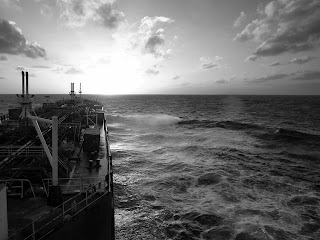








This is a unique class of vessels that were built in the early 1980's to
circumvent some regulations in order to decrease required manning levels
(among other requirements). The result was a design that was attempted only
a handful of times, has always been more of a pain for any shipyard periods
than an actual benefit to anybody (although I would think some acountants
might want to argue).
This is a class of vessels that will have shortly become all but extinct.
This is an ITB or an Integrated Tug Barge. This is not an ATB (Articulated
Tug Barge, where tug is pinned to the barge in a pivoting-type connection).
Integrated stands for a rigid integration where tug engages with the barge
via a long tong at barge's after end and corresponding "cradle" within tug's
pontoons. Resulting connection secures the two together and cannot be pulled
apart unless very specific draft and trim conditions of each unit are met.
In reality the two come only apart for shipyard and drydocking. Given the
amount of water that has to be moved in order to attain disconnect
condition, the process of disconnecting is around 2-3 days long, somewhat
less for reconnection.
Pictures show the tug after it was disconnected (end of the barge's tong is
also visible) and the same tug in the drydock in Portland Oregon.
...
Received: from GCC at Globe Wireless;
Wed, 27 Jan 2010 14:30 UTC
Message-id: 613875780















